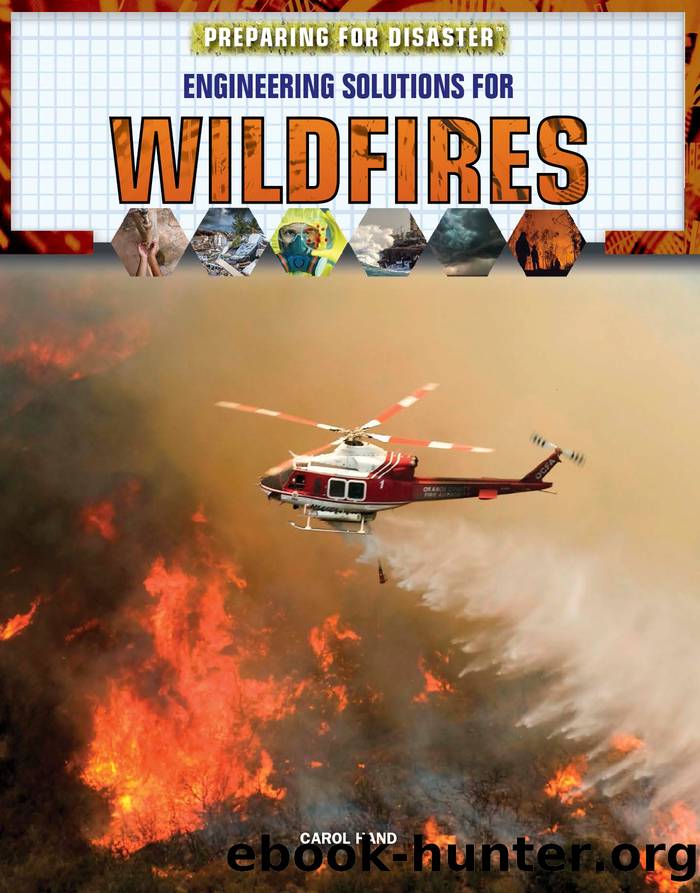Engineering Solutions for Wildfires by Carol Hand

Author:Carol Hand [Hand, Carol]
Language: eng
Format: epub
ISBN: 9781725347885
Google: HhAcwwEACAAJ
Publisher: Rosen Publishing
Published: 2019-12-15T23:33:51.010929+00:00
Crews fighting the 2018 Camp Fire in Butte County, California, received help from the California National Guard. A Black Hawk helicopter drops water on the fire.
Although firefighting equipment has changed little in the past forty years, new tools, techniques, and technologies are needed to fight larger, more intense fires. Sometimes, existing technologies are adapted to do more. Helicopters and air tanker planes dump water or fire retardant on fires. Aircraft are also being used for close observation or fire surveillance. Air tankers are equipped with cameras and GPS equipment to follow fires. Information from these tools is fed into computers to improve fire models.
Digital Technologies and Satellites
New types of digital technology may also change the face of twenty- first-century firefighting. An article from Digital Transformation lists five digital technologies that could soon transform firefighting: satellites, drones, robots, virtual reality (VR), and the Internet of Things (IoT).
Since 2013, the University of California, Berkeley, working with a Reno company, Fireball, has conducted a project called Fire Urgency Estimator in Geosynchronous Orbit (FUEGO). FUEGO collects infrared (heat) images and other data and develops them into maps. Its satellite and drone technologies monitor early wildfires before they burn out of control. A group of engineers from the University of Alberta in Canada is working on a satellite, called Ex-Alta 2, that is designed to predict, track, and assess wildfires. The satellite is less expensive than others because many of its computer programs are open source, or freely available.
Ground-based robots can fight fires directly. Thermite, a robot developed by Howe and Howe Technologies of Maine, battles wildfires in extreme conditions. It keeps human firefighters safer. Remotely piloted drones, or flying robots, equipped with heat and wind sensors are being used to observe fires from above. No pilots are put at risk, and drones can remain in the air much longer than piloted planes. They can fly at night and into areas that piloted planes cannot. Their information helps firefighters on the ground figure out where to send people and supplies. According to Michael Alba on Engineering.com, a series of drones can be connected by computers. Drone launchpads would be placed about every 10 miles (16 kilometers) around vulnerable communities.
Download
This site does not store any files on its server. We only index and link to content provided by other sites. Please contact the content providers to delete copyright contents if any and email us, we'll remove relevant links or contents immediately.
Machine Learning at Scale with H2O by Gregory Keys | David Whiting(3664)
Never by Ken Follett(3550)
Fairy Tale by Stephen King(2973)
Will by Will Smith(2595)
Fantastic Beasts and Where to Find Them: The Original Screenplay by J. K. Rowling(2416)
The Storyteller by Dave Grohl(2073)
It Starts With Us (It Ends with Us #2) by Colleen Hoover(2059)
Friends, Lovers, and the Big Terrible Thing by Matthew Perry(2018)
Can't Hurt Me: Master Your Mind and Defy the Odds - Clean Edition by David Goggins(2012)
The Becoming by Nora Roberts(1932)
Cloud Cuckoo Land by Anthony Doerr(1925)
New Morning Mercies: A Daily Gospel Devotional by Paul David Tripp(1821)
HBR's 10 Must Reads 2022 by Harvard Business Review(1703)
The Complete Witcher by Andrzej Sapkowski(1701)
Cytonic by Brandon Sanderson(1687)
A Short History of War by Jeremy Black(1679)
Go Tell the Bees That I Am Gone by Diana Gabaldon(1602)
Leviathan Falls (The Expanse Book 9) by James S. A. Corey(1530)
515945210 by Unknown(1525)
